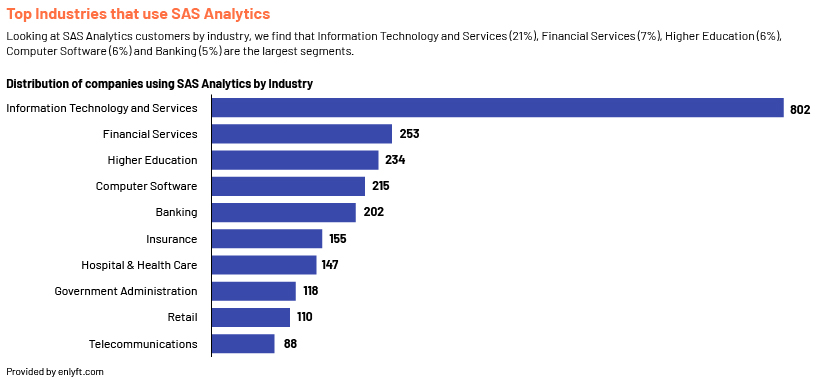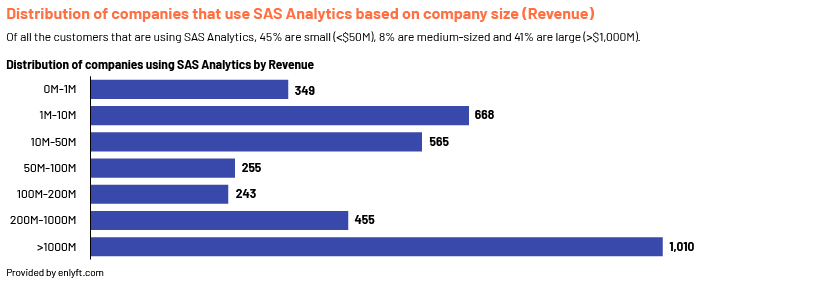Published on October 6, 2023 by Manish Kumar Agarwal
Introduction
SAS is a leading analytics software company that provides a wide range of business solutions for a number of sectors, such as banking, healthcare and retail. This blog provides an overview of its software of the same name and its use specifically in healthcare and sectors other than banking. We also compare its market share with that of other analysis software currently available in the market.
Statistical Analysis System (SAS) is used widely in sectors such as the following:
-
Financial services: Banks, insurance companies and other financial institutions use SAS for risk management, fraud detection and customer analytics.
-
Healthcare: Hospitals, pharmaceutical companies and other healthcare organisations use SAS for clinical trial analysis, population health management and medical research.
-
Retail: Retail companies use SAS for supply-chain optimisation, customer segmentation and marketing analytics.
-
Telecommunications: Telecommunications companies use SAS for network optimisation, customer profiling and fraud detection.
-
Government: Local, state and federal government agencies use SAS for data analysis, fraud detection and programme evaluation.
-
Oil and gas: Companies in the oil and gas sector use SAS for data analysis, exploration and production optimisation, and risk management.
-
Manufacturing: Manufacturing companies use SAS for supply-chain optimisation, quality control and predictive maintenance.

The type of analysis conducted:
-
Finance: Used for risk management, fraud detection and compliance. Banks, insurance companies and other financial institutions use SAS to analyse large volumes of data and identify patterns that may indicate fraudulent activity or potential risks. SAS is also used for credit risk modelling, stress testing and regulatory reporting.
-
Healthcare: Used for clinical trial analysis, disease surveillance and population health management. Pharmaceutical companies use SAS to analyse clinical trial data and identify patterns to help them develop new drugs. Hospitals and healthcare providers use SAS for disease surveillance and population health management, allowing them to identify and track health trends and risks in their patient populations.
-
Retail: Used for supply-chain optimisation, customer segmentation and marketing analytics. Retail companies use SAS to analyse customer data and develop targeted marketing campaigns to help them attract and retain customers. SAS is also used for supply-chain optimisation, allowing retailers to manage inventory levels and reduce costs.
-
Telecommunications: The sector relies heavily on data analytics to manage network operations, customer service and marketing efforts. Telecommunications companies use SAS to analyse network performance data, customer behaviour data and marketing campaign data. SAS is also used for fraud detection, allowing telecom companies to identify and prevent fraudulent activity on their networks.
-
Government: Government agencies use SAS for data analysis, fraud detection, and programme evaluation. SAS is used by local, state and federal agencies to analyse large volumes of data and identify patterns to help them improve programme outcomes and prevent fraud. SAS is also used for predictive modelling, enabling agencies to forecast trends and plan accordingly.
-
Oil and gas: Used for data analysis, exploration and production optimisation, and risk management. Oil and gas companies use SAS to analyse data from drilling operations, production facilities and transport networks. SAS is also used for risk management, enabling companies to identify potential hazards and take steps to prevent accidents and environmental damage.
-
Manufacturing: Manufacturing companies use SAS for supply-chain optimisation, quality control and predictive maintenance. SAS is used to track inventory levels, optimise production schedules and identify opportunities for cost savings. SAS is also used for predictive maintenance, enabling companies to identify potential equipment failure and take corrective action.
Additional ways in which SAS is used in the healthcare sector:
-
Track diseases: Public health agencies use SAS to monitor and track the spread of infectious diseases. For example, SAS can be used to analyse data from electronic health records, laboratory reports and other sources to identify outbreaks of diseases such as influenza or COVID-19. This information can help public health officials take action to prevent the spread of disease and protect public health.
-
Improve quality of healthcare: Healthcare organisations use SAS to monitor and improve the quality of care they provide to patients. SAS can be used to analyse data on patient outcomes, readmission rates and other quality indicators to identify areas where improvements can be made. For example, a hospital may use SAS to analyse data on patient falls, identify common causes of falls and implement interventions to reduce the risk of falls.
-
Manage population health: SAS can be used to analyse data on patient populations to identify health trends and risks. This information can be used to develop targeted interventions to improve the health of specific patient populations. For example, a health insurer may use SAS to analyse member data to identify patients with chronic conditions such as diabetes and develop targeted interventions to help these patients manage their condition and improve their health outcomes.
-
Analyse claims: Healthcare payers use SAS to analyse claims data to identify trends and patterns in healthcare utilisation and cost. This information can be used to develop cost-saving strategies and improve the efficiency of healthcare delivery. For example, an insurance company may use SAS to analyse claims data to identify high-cost procedures or treatments and negotiate lower prices with providers.
Techniques being used to perform this analysis:
-
Predictive modelling: SAS can be used to develop predictive models that can help healthcare organisations forecast trends and plan accordingly. For example, a hospital may use SAS to develop a model to predict patient readmissions, enabling it to identify patients at risk of re-admission and implement interventions to prevent re-admission.
-
Fraud detection: SAS can be used to detect healthcare fraud and abuse by analysing claims data and identifying suspicious patterns of billing. For example, an insurance company may use SAS to analyse claims data and identify providers billing for services not actually provided, or for services that were medically unnecessary.
-
Personalised medicine: SAS can be used to analyse genomic data and develop personalised treatment plans for patients. For example, a cancer centre may use SAS to analyse a patient's genomic data and identify specific mutations driving growth of the cancer. This information can be used to develop a personalised treatment plan that targets those mutations.
-
Clinical decision support: SAS can be used to develop clinical decision support tools to help healthcare providers make more informed treatment decisions. For example, a hospital may use SAS to develop a tool that analyses patient data and provides recommendations on the most effective treatment options for a particular condition.
-
Health IT analytics: SAS can be used to analyse data from electronic health records, health information exchanges and other health IT systems. This information can be used to identify trends and patterns in healthcare utilisation and cost, and to develop strategies to improve the efficiency and effectiveness of healthcare delivery.
Overall, SAS is a versatile tool that can be used in a wide range of healthcare applications, from fraud detection to personalised medicine to clinical decision support. By providing powerful data analytics capabilities, SAS can help healthcare organisations improve patient outcomes and reduce costs.
SAS has a strong market share in the analytics software sector. SAS has a 12.1% market share in the advanced analytics market, according to a 2020 Gartner report. It is ranked third, behind IBM and Microsoft. However, SAS is the market leader in the healthcare analytics market, with a 30% market share.

Conclusion
SAS is an analytics software used by a number of sectors, including healthcare, finance and retail. It is used for advanced analytics, data management and business intelligence. SAS has a strong market share in the analytics software market, with a significant presence in the healthcare sector. Its use in the healthcare sector has helped healthcare organisations improve patient outcomes, reduce costs and enhance operational efficiency.
How Acuity Knowledge Partners can help
As a leading provider of high-value research, analytics and business intelligence, we offer a full suite of market research services. We started using AI in survey analytics to extract sentiment and dive deep into digital conversations using social media and verbatim survey responses. We plan to take significant strides in this space and follow a well-researched approach founded on our two decades of experience in the market research domain.
Sources:
What's your view?
About the Author
Manish Kumar Agarwal Primary Research and Customer Insights professional with a demonstrated history of working throughout the life cycle of Analytics and Advisory Research Projects across diverse industries and geographies.
Proven track record in driving client satisfaction and business growth through actionable insights from survey analytics and sentiment analysis.
Skilled in real-time feedback monitoring, trend analysis, and stakeholder engagement along with survey design, data analysis, and delivering actionable insights through BI dashboards.
Proficient in Python, SQL, SPSS, and BI Dashboards, with hands-on experience in Qualtrics and Forsta. Adept at integrating structured and unstructured data to support strategic decision-making and enhance customer and employee experience.
Like the way we think?
Next time we post something new, we'll send it to your inbox








